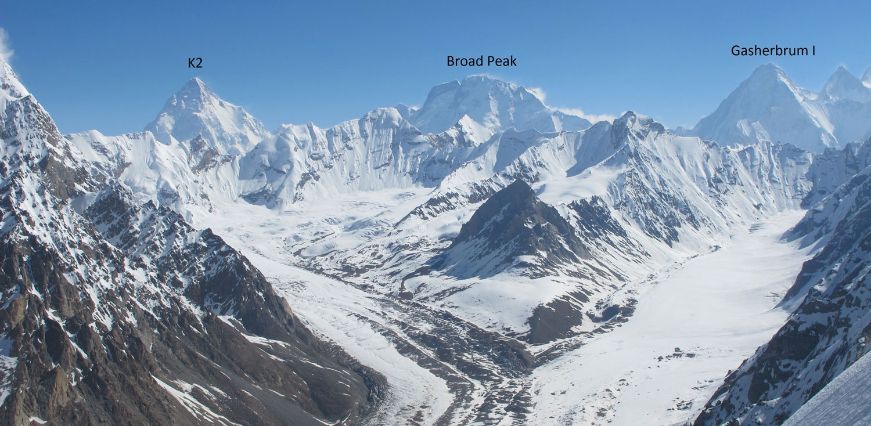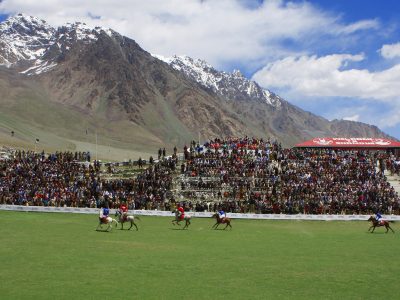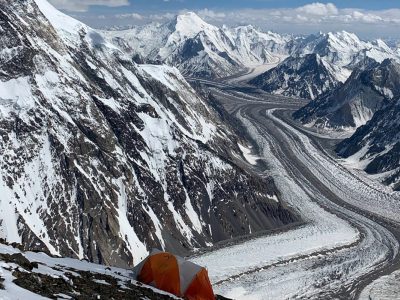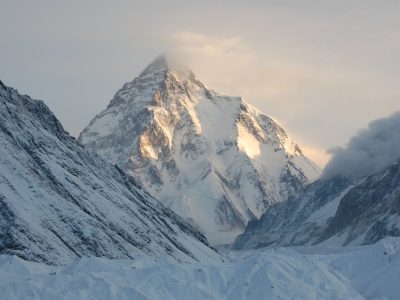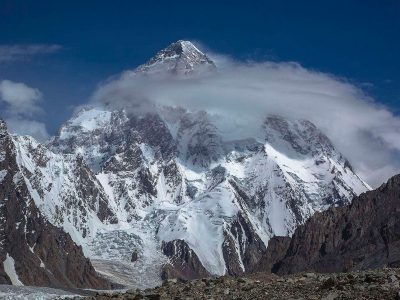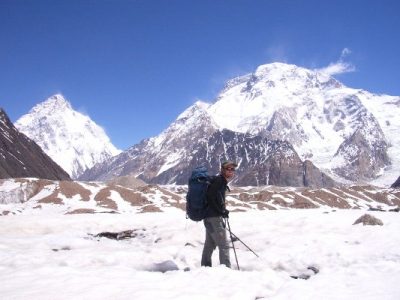Broad Peak Climbing Expedition
Broad Peak Expedition Pakistan stands at a towering 8047 meters. It is part of the Karakoram Range, nestled near the Baltoro Glacier, adjacent to the renowned K2. This unique triple-summit peak distinguishes it, adding to its distinctive allure in mountaineering. Though it might not claim the same fame as K2, it commands its majestic presence, offering a compelling challenge to seasoned climbers and adventurers, primarily due to its peculiar summit layout.
Expedition Highlights:
- Thrilling mountaineering journey in the heart of the Karakoram.
- 12th highest mountain globally, reaching 8,051 meters.
- Navigate through diverse landscapes with crucial weather preparations.
- Conquer the summit with a rich history of achievements.
Height:
Standing proudly as the 12th highest mountain in the world, Broad Peak, locally known as 'Falchan Kangri,' reaches an elevation of 8,051 meters (26,414 feet) above sea level. Named for its sheer bulk and breadth at the top, it dominates the skyline, showcasing its formidable presence neighbouring K2.
Weather:
The weather conditions play a crucial role in the success of the Broad Peak Expedition. The expedition typically spans from Islamabad International Airport, the nearest international airport, to Skardu, offering a spectacular mountain view flight. From Skardu, trekkers journey through the mighty Indus, Shigar, and Braldu Rivers to reach Askoli, the last village, before entering the wilderness of the Karakoram mountains. Weather preparations are essential, and the journey unfolds amidst the stunning landscapes of the Himalayas and Karakoram Mountain Peaks.
Trekking Route:
The journey from Skardu unfolds through a scenic trail leading to Askoli, marking the final village before embarking upon the trek. The route continues to Paiju, strategically pausing for a day's rest as porters prepare provisions for the glacier leg of the journey. Further, it progresses to Urdukas, an idyllic spot showcasing the Trango Towers and Uli Biaho. The voyage culminates at Concordia, revealing breathtaking views of the grandeur of K2, Broad Peak, and Gasherbrum IV.
Access and Base Camp:
The expedition to Broad Peak commences from Islamabad, Pakistan's capital, and Rawalpindi, a city adjacent to Islamabad. The journey includes completing essential governmental formalities crucial for any mountaineering venture. The path then leads to Skardu in the Baltistan district, with two primary travel options—by air, a swift one-hour flight presenting stunning aerial views of Nanga Parbat, or by road, following the mesmerizing Karakoram Highway, providing a more immersive experience despite its extended duration. Skardu acts as the crucial stepping stone before the actual trekking phase.
Base Camp and Climbing Strategy:
The expedition at Base Camp, positioned at 5,000 meters, involves meticulous planning for a successful ascent. The climb is characterized by multiple sub-camps at strategic elevations of approximately 5800, 6250, and 6900 meters. Climbing Broad Peak demands caution due to challenging avalanche-prone terrain. Climbers typically strategize their ascent, choosing between camps like Camp 3 or a supplementary camp established at 7400 meters.
First Summit:
The summit of Broad Peak, achieved for the first time in June 1957 by Fritz Wintersteller, Marcus Schmuck, Kurt Diemberger, and Hermann Buhl, is a testament to the spirit of adventure and mountaineering prowess. Climbing through a rock gully to Camp I (6,000m) and ascending through a large snow face to Camp II at around 6,400m, the expedition culminates at a final camp at 7,400m. While the climbing may not be extremely steep, the remote setting adds to the challenge, uniquely rewarding the experience.
History:
Winter Attempts (1987/88):
Winter expeditions gained momentum as Andrzej Zawada led the first International Winter Expedition to K2. Although the team failed on K2, Aleksander Lwow and Maciej Berbeka attempted Broad Peak, reaching the Fore Peak.
South West Face (2005):
Denis Urubko and Serguey Samoilov climbed a new route up the South West Face in Alpine style, marking a significant achievement in 2005.
West Face Variation (2008):
Valery Babanov and Victor Afanasiev climbed Broad Peak's central pillar up the West Face via a variation route in alpine style in 2008.
Recent Summits (2019/2023):
In 2019, 17-year-old Shehroze Kashif became the youngest to summit. In 2023, Nirmal Purja and Migma G added to the mountain's legacy in their quest to climb all 14 8,000-meter peaks without supplemental oxygen.
Tour Detail:
D-1) ARRIVAL DAY IN ISLAMABAD, PAKISTAN:
Welcome to Pakistan. Most international flights arrive at Islamabad International Airport in the mornings. Your Guide will meet and greet you at the airport and then transfer you to the hotel. The rest of the days are free to recover from your journey. Later in the day, when everyone has arrived, we will have a group briefing about the Broad Peak Expedition. Depending on the time available to us, there may be an option to do some sightseeing in Islamabad, A purpose-built City in 1961 as the new capital of Pakistan.
- ACCOMMODATION
- Hill View Hotel or similar
- MEALS
- Breakfast, Lunch, Dinner.
D-2) ISLAMABAD TO SKARDU FLIGHT, 45 minutes (2,230m):
If canceled, Drive KKH to Chillas, Isb to Chillas, 461km. 8-9 H-Drive
Rise early to take a spectacular mountain view flight (weather permitting) across The Karakoram and Himalayan mountain range to Skardu, the capital of Baltistan. It's a 45-minute flight that offers fantastic mountains views of the Himalayas & Karakoram mountains; it also enjoys the breathtaking views of the world's 9th highest peak, Nanga Parbat (8,126m); if the weather is clear, then you might be able to see K2 and Gondogoro Pass as well. Check in to the hotel, rest of the day will be spent visiting the local Bazars, historical forts, and scenic lakes or see the ancient rock inscriptions, one of which is of 8th century Manthal Lord Buddha Rock that shows traces of Buddhist monks and pilgrims who influenced the area before Islam.
- ACCOMMODATION
- Summit Hotel or similar
- MEALS
- Breakfast, Lunch, Dinner.
D-3) SIGHTSEEING & PREPARATION DAY, SKARDU:
In the morning, you can walk up to the remains of Kharpocho Fort (built early 1700), which overlooks the town and has a great view of the Indus River. If you are into photography, this is a perfect location to take photos of Skardu Town at sunrise or sunset. (we can arrange this for you). We will then walk to a small village called Organic Village, which grows all its crops organically. The afternoon is free to explore. Perhaps you would like to take an optional jeep tour to Satpara Lake or explore the bazaar. Skardu is the getaway to many famous Karakoram mountains, including Broad Peak.
- ACCOMMODATION
- Summit Hotel or similar
- MEALS
- Breakfast, Lunch, Dinner.
D-4) SKARDU TO JOHLA via ASKOLI (3,100m) 8 HOURS DRIVE:
After breakfast, you will drive in a jeep along the mighty Indus, Shigar, and Braldu Rivers to reach Askoli. Askoli is the last village. Before you enter into the wilderness of the Karakoram, you will meet your porters. Askoli is a single street of wooden houses backed by irrigated fields of corn, potatoes, and groves of apricot trees.
After a short break, you drive through the lanes and fields of Askole, which will be the last settlement we will encounter on our trek to Concordia. Watching the local people go about their daily business is a fascinating insight into the lifestyle of the hardy Balti people. The valley opens out to reveal the Biafo Glaciers; we have our first taste of moraine walking; we cross the glacier snout and descend to the green spot beside the river at Korofong.
From Korofong, follow the road up a side valley to do a detour to cross the fast-flowing river by a jeep bridge. You then drive for another half an hour to reach the Jhola Camp. The views are impressive, with Bakhor Das (5,809m) and Paiju Peak's needles in the distance. From Jhola, you continue onto Bardumal campsite for a night stay.
- ACCOMMODATION
- Summit Hotel or similar
- MEALS
- Breakfast, Lunch, Dinner.
D-5 TREK TO PAIJU (3,380m) 6 HOURS WALK:
After organizing all the equipment and supplies, your porters load up for the journey towards Paiju. Today will be your first walking day of the Broad Peak Expedition, so make sure you have plenty of water.
For a while, the trekking route runs at the very edge of the river, before climbing to higher ground and allowing us excellent views of the impressive Paiju Peak. Today, you have to negotiate a couple of streams; depending on the melting of the glaciers above, you may have to fold these (sports sandals or old trainers are useful). Paiju is a green oasis under the shadows of Paiju Peak (6,611m). From here, we will have the first view of the immense Baltoro Glacier and the granite peaks of the Trango towers, and if the weather is clear, then enjoy a first glimpse of the mighty K2.
- ACCOMMODATION
- Summit Hotel or similar
- MEALS
- Breakfast, Lunch, Dinner.
D-6)TREK TO KHOBURTSE (3,760m) 7 HOURS WALK:
From your camp at Paiju, a walk of approximately one hour brings you to the snout of the Baltoro Glacier. After viewing the outpouring of meltwater from the ice, we now climb up onto the back of this great beast. At this point, the glacier's ice is completely covered by rubble and rocks. Although we follow a trail many expeditions use, going here can be quite tough. The trail undulated as we climbed over the swells of the flowing glacier. It is fascinating to think that the stones underfoot could have come from the summit of Broad Peak, Gasherbrum, or K2.
Gradually, we work our way across the glacier to its south side, where we can use a path along the lateral moraine. Heading roughly east, we continue, sometimes on the moraine and sometimes down beside the glacier until we reach a side valley. At this point, it may be possible to continue directly by climbing onto the glacier. Or, if the glacier is not easily accessible, we will turn off into the valley for approximately half an hour to reach a point where we can cross the meltwater stream (sandals or old trainers are required). Finally, getting the camping place at Khorburtse (3,760m), we have sensational views of the Cathedral Towers, the Trango Group, and the striking rock tower of Uli Biaho. A great day of trekking over difficult and mixed terrain.
- ACCOMMODATION
- Summit Hotel or similar
- MEALS
- Breakfast, Lunch, Dinner.
D-7) TREK TO URDUKAS (4,130m) 4 HOURS WALK:
Today is a short day but quite hard work as we walk up the undulating moraine and gain height all the way. You continue east beside the Baltoro Glacier along the lateral moraine or sometimes on the glacier itself, passing the ship-like prow of Great Trango Tower and the isolated pillar of the 'Nameless Tower' to your next camp at Urdukas. It has truly sensational views of the Trango Towers to the west and directly opposite, and almost a mile away across the valley, the vast rock walls of Cathedral Peak and Lobsang rise like ramparts above the glacier. This is a truly awesome place. It would help if you reached here in time for a late lunch, and the rest of the afternoon is free to camp, relax, and soak up our fabulous situation.
- ACCOMMODATION
- Summit Hotel or similar
- MEALS
- Breakfast, Lunch, Dinner.
D-8) ACCLIMATISING DAY AT URDUKAS (4,130m):
From many years of experience, we have learned that taking a rest day at Urdukas has worked well for the Broad Peak Expedition teams; the advantages of spending an extra night here are very helpful. It helps acclimatize and has proved more effective than a rest day at Paiju.
This is the last campsite on grassy slopes off the main glacier; it also has facilities for washing and cleaning. There is a pleasant walk behind the campsite through grassy slopes full of alpine flowers. Climbing high & sleeping low is the best way to help acclimate.
- ACCOMMODATION
- Summit Hotel or similar
- MEALS
- Breakfast, Lunch, Dinner.
D-9) TREK TO GORO II (4,250m) 7 HOURS WALK:
Leaving Urdukas behind, you follow the moraine edge eastwards until it is possible to climb up onto the broad back of the glacier. The trail on the Baltoro goes past the Yermanandu glacier, which flows from Masherbrum. There are views of Muztagh (7,270m), Masherbrum (7,800m), and Gasherbrum IV at the head of the Baltoro and Concordia. You are high now and camping on one of the largest pieces of ice outside the polar regions so that we will warm up for the cooler nights ahead. The campsite is on the glacier where ledges have been leveled out for the tents.
- ACCOMMODATION
- Summit Hotel or similar
- MEALS
- Breakfast, Lunch, Dinner.
D-10) TREK TO CONCORDIA (4,600m) 5 HOURS WALK:
Today, you will Trek to the Magnificent Concordia, arguably the most spectacular mountain scenery anywhere in the world! Our approach to Concordia continues along the heaving swells of the Baltoro Glacier as we pass Mustagh Tower (7,284m). Ahead of us, Gasherbrum IV (7,925m) acts like a beacon drawing us on. At the same time, at some points on today's walk, we can also see Gasherbrum ll (8,035m), which peeks out to the right of Gasherbrum lV.
As we make our way up the Baltoro, the aptly named Broad Peak (8,051m) comes into view above the ridge connecting Marble Peak and Crystal Peak on our left. K2 keeps itself hidden until we reach Concordia when its full height is suddenly revealed in sweeping lines that climb almost 4000 meters from the valley floor to the summit. This site will never be forgotten. Concordia is a wide area where glaciers coming down from K2 meet those from the Gasherbrums and Chogolisa. It is undoubtedly one of the most spectacular places on the planet; here, you can stand within 24 kilometers of no fewer than four eight-thousanders and ten of the world's thirty highest peaks! We camp at approximately 4,500 meters on a moraine ridge surrounded by jagged peaks, including Gasherbrum IV, Mitre Peak, Chogolisa, Crystal Peak, Marble Peak, Baltoro Kangri, Broad Peak, and K2.
- ACCOMMODATION
- Summit Hotel or similar
- MEALS
- Breakfast, Lunch, Dinner.
D-11) TREK TO BROAD PEAK BASE CAMP (5,000m) 4 HOURS WALK:
Rise and shine early to enjoy the spectacular sunrise view on K2 and other Karakoram giants. Have your breakfast, then start walking the the base camp of Broad Peak. The route passes through some jumbled ice fins and moraine ridges from Concordia before gaining the medial moraine of the Godwin-Austen glacier. Broad Peak Base Camp is located on this moraine near the base of the climbing route on Broad Peak. One of the best views of K2 is from Broad Peak Base Camp. Enjoy the marvelous situation of Karakoram.
- ACCOMMODATION
- Summit Hotel or similar
- MEALS
- Breakfast, Lunch, Dinner.
Day-12-52) CLIMBING & ACCLIMATISING PERIOD:
Your climbing session of the Broad Peak Expedition will start from today onwards. Our Guide, Chef, and other staff will stay at the base camp to help and assist you during the climbing period. Our professional Chef will make delicious and nutritious food which will play a great role in climbing a mountain.
- ACCOMMODATION
- Summit Hotel or similar
- MEALS
- Breakfast, Lunch, Dinner.
D-53) TREK BACK TO KHOBURTSE (3,560m) 7 HOURS WALK:
After the climbing season of the Expedition, you will start descending Baltoro Glacier by following the same itinerary backward. It is amazing how different everything looks in descent, with our constant field of vision now filled with an entirely different view. The drop in altitude starts to become more noticeable as the granite walls and spires lining the glacier, which yesterday looked almost lower than us, now tower to lofty heights above. It is also a little warmer, with more oxygen in the air. Passing through the campsite of the Duke of Abruzzi at Urdukas we can marvel at the tenacity of those early pioneers who endured untold hardship simply to get to their base camps. After taking lunch on the Duke's terrace, with sensational views across the glacier to Biale Peak, which remains hidden except from this vantage point, we continue trekking down this huge valley, sometimes on the glacier and sometimes along the moraine or the valley sides until we reach Horbose, our first off-glacier camp for some days. Now, we can make out the end of the glacier and the start of the valley of the Braldu. We can even see the patches of green on the lower slopes of Paiju Peak, which mark the location of the spring water camp.
- ACCOMMODATION
- Summit Hotel or similar
- MEALS
- Breakfast, Lunch, Dinner.
D-54) TREAK BACK TO PAIJU (3,380m) 5-6 HOURS WALK:
Continue your trek on the Baltoro Glacier with spectacular views of the Trango Towers towards Paiju. On our approach, we have to detour to the south to cross the Liligo Glacier. This glacier defies world trends in that it is steadily growing. Twenty years ago, its snout was half a mile up the valley. Now, it has collided with the main Baltoro Glacier, resulting in the churning forces making it impossible to cross without the detour.
Having made the detour and returned to the main Baltoro Glacier, you now cross to its north side, climbing over the huge swells of the glacier towards the ramparts of Uli Biaho. On the other side, we then work our way down to the valley, where we pick up the main trail and pass by the snout, where the underground river, which flows through the length of the glacier, erupts out in a cascade to become the Braldu. The last hour of the day is an easy walk on a good path, although there is a final uphill pull to reach the campsite. On our first arrival here, we relished the prospect of a cooler climate ahead. Now, you will welcome its warmth! We will spend our night at the green oasis of Paiju.
- ACCOMMODATION
- Summit Hotel or similar
- MEALS
- Breakfast, Lunch, Dinner.
D-55) TEAK BACK TO JHOLA (3,170m) 7 HOURS WALK:
Now you are off the glacier, and at a lower elevation, it is considerably warmer. We may make an early start to use the cool of the morning. Leaving Paiju we walk on a good trail down the valley. Once again, it is surprising how different the experience is compared to our ascent. The trail rises and falls as we cross several alluvial fans. We must cross some side streams today, mostly using makeshift bridges or stepping stones. Still, it may be necessary also to wade across, especially later in the day. The source of all these streams is meltwater, so they grow bigger as the day gets warmer. At one point, the trail passes close to the river beside the walls of the conglomerate, and it is possible to feel its tremendous power. You follow the main Braldu River downstream to its confluence with the Panma River. You turn northeast to reach the Jhola camping place beside the toll bridge.
- ACCOMMODATION
- Summit Hotel or similar
- MEALS
- Breakfast, Lunch, Dinner.
D-56) TREAK BACK TO ASKOLI (3050m) 3-4 HOURS WALK:
This will be our final trekking day of the Broad Peak Expedition and our return to civilization after two weeks in the wilderness. Soon, we will follow a pleasant trail that leads down to the little ablation area beside the Biafo Glacier known as Korofon, surrounded by sparse grasses and tamarisk bushes. Beyond Korofon, we first follow the glacial moraine of the Biafo glacier and then walk beside the river that emerges from its snout until we reach a bridge that allows us to cross to its north side. The trail passes through a wide flat area known locally as the 'King's Polo Ground' before climbing to pass through a convenient cleft in a ridge of rock, which threatens to bar further progress down the valley. Descending steeply down the other side of this 'window,' we have a pleasant stroll through a boulder-strewn landscape before climbing again up onto a shallow plateau. We cross several small side valleys and begin to see signs of habitation before reaching an irrigation channel that brings meltwater to the field of Askoli. We follow the channel for a while and can appreciate the tremendous skill of the local people who have harnessed the distant snows to grow their crops in a high-altitude desert. Eventually, we reach green fields and stone walls, which lead us into the village. Most porters are from Askoli and will be pleased to be home. To get to our campsite at the road head, we must first walk through the outlying fields and then descend from the little plateau on which the village is located.
Today, you can celebrate your success on the Broad Peak Expedition with the porters and hand out their tips as a token of our appreciation for their hard work throughout the trek. Also, we often give them any spare kit that we no longer need which is also a way of saying thank You. Most of our porters are from this village, so later on at the campsite, we will say goodbye to our crew, who are now our friends, and we will perhaps have a final party here.
- ACCOMMODATION
- Summit Hotel or similar
- MEALS
- Breakfast, Lunch, Dinner.
D-57) DRIVE BACK TO SKARDU VIA SHIGAR VALLEY, 7 HOURS DRIVE:
Our vehicles will already be waiting for us in Askoli, so we make an early start for the return to Skardu. Crossing the Braldu on a suspension bridge, we follow the remarkable road built through the Braldu Gorge. It is not uncommon for this road to be blocked by landslides, and we may have to change vehicles if the road is blocked. If so, we will retain some porters to transfer the bags while walking across landslide areas. Once we have climbed out of the gorge at the other end, the road improves as we travel down the fertile Shigar Valley to its confluence with the Indus. We have a faster, smoother journey on a paved road following the great Indus River into Skardu. Arriving in the town we will check in to our hotel, and there will be time for a welcome shower and clean up before sitting down to dinner. Tonight, we will enjoy the comfort of a real bed.
- ACCOMMODATION
- Summit Hotel or similar
- MEALS
- Breakfast, Lunch, Dinner.
D-58) FLY BACK TO ISLAMABAD:
If the weather is clear, we will drive to Skardu airport to fly to Islamabad. Skardu Airport is a 40-minute from the hotel along a good road lined with poplar trees. Boarding our plane we have an exciting flight out of the valley, once again passing by Nanga Parbat before turning south for Islamabad. Arriving in the Pakistani capital after a period in the mountains is always a strange experience. It takes a little time to get used to the hustle and bustle, especially the traffic. Our private bus will be waiting at the airport to transfer us to the group hotel; once we have settled in, it will be time to take lunch (unless we have experienced unusual flight delays). After lunch, the rest of the day is free for independent sightseeing or to relax at the hotel. Your Guide will advise you on the possibilities for sightseeing. Shopping for hand-made Iranian & Afghan rugs is a usually popular option. This evening, we reunite for a celebratory meal at the hotel or in a local restaurant.
In Case of Flight cancellation, we will drive down the Karakoram Highway. We will arrive in Chillas/Naran in the afternoon.
- ACCOMMODATION
- Summit Hotel or similar
- MEALS
- Breakfast, Lunch, Dinner.
D-59) CONTINGENCY DAY IN CASE OF DELAYS-ISLAMABAD:
We will arrive in Islamabad late afternoon if we drive down the Karakoram Highway. If we fly the day before, we will spend today sightseeing in Islamabad. In the evening, we will have a final group meal.
Skardu is a 'weather dependent' airport, which means the planes will only fly here if the visibility allows line of sight to the runway by the pilot on the approach. Fortunately, the weather is mostly clear in the Karakoram. Still, local weather conditions can bring clouds and rain from time to time. If we cannot fly, we will travel down to Islamabad by road along the spectacular Karakoram Highway. If we pass up to Skardu, this will be a bonus as it is a fantastic travel experience in its own right. The drive down the Indus River to Islamabad takes two days, so this is an important contingency day to allow for this. If we have flown to Islamabad, this will be a further day for sightseeing in the capital, and your leader will advise the group on the options available.
- ACCOMMODATION
- Summit Hotel or similar
- MEALS
- Breakfast, Lunch, Dinner.
D-60) DEPARTURE DAY-FLY BACK HOME:
After Breakfast, you will be transferred to Islamabad International Airport for your return flight. End of "Broad Peak Expedition".
Activities
Climbing Expedition




